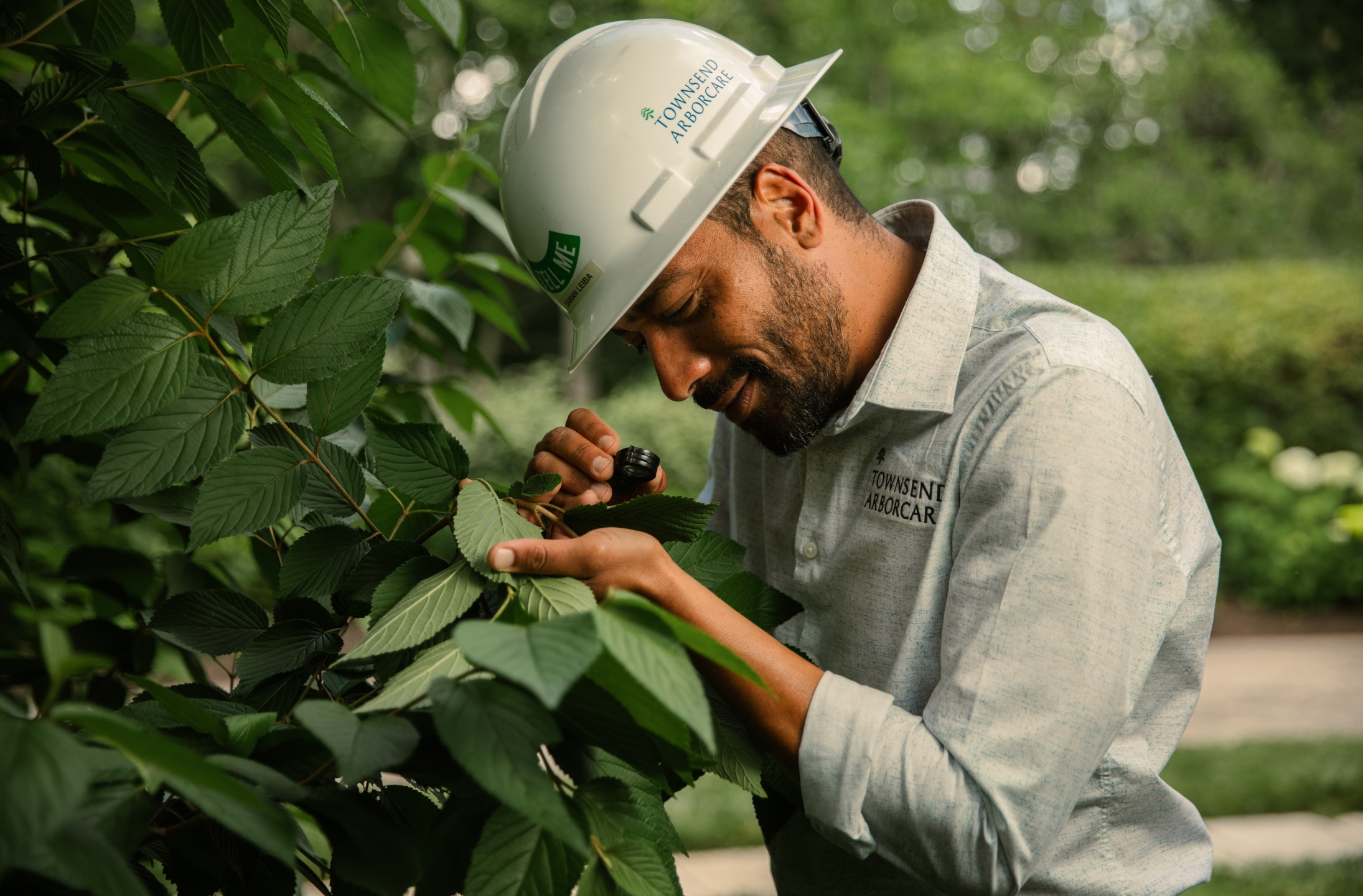Ask an Arborist
Townsend Arborcare is proud to be your go-to resource for all things tree care. See our growing collection of submitted questions and answers from our certified arborists on tree maintenance, safety procedures, environmental impacts and more.

Tree Pruning and Maintenance
Many are surprised we recommend pruning oak trees in the winter when there are no leaves to visibly see what’s dead or alive? Pruning during these months greatly reduces the risk of Oak wilt infection, a deadly fungal disease spread by beetles. This fungal disease is lethal to many oaks and typically spreads by sap-feeding beetles attracted to fresh wounds on oak trees. If a beetle from an infected tree carries spores to a healthy tree, it can lead to infection.
During the colder months, these beetles are less active, and the viability of the oak wilt spore decreases over time.
We are often asked, “How do you tell the difference between live and dead limbs?” Here are several tactics we use:
- Bark appearance: Dead bark often looks dry, shriveled, peeling, or cracked.
- Scratch test: We scrape a small section of the bark to distinguish between dead and live limbs.
- Flexibility test: We gently bend small limbs; dead limbs typically break, while live limbs bend.
- Buds: We check for visible buds on branches; no buds usually indicate the branch is dead.
The optimal time to prune most trees in Indiana and Ohio is in late winter or early spring, before new buds (deciduous) and candles (conifers) emerge. During dormancy, arborists can clearly inspect the tree canopy without foliage obstruction, identifying and addressing issues such as dead, dying, cracked, or broken branches. Pruning during this period allows cuts to seal faster, aiding the tree’s natural wound compartmentalization and reducing the risk of insect or disease stressors.
However, there are exceptions:
- Early spring bloomers (e.g., crabapples, magnolia, forsythia): Prune in late spring after blooming.
- Trees with lots of sap flow (e.g., birch, maple, dogwood): Prune in mid-summer or late fall to avoid sap bleeding.
- Storm-damaged trees: Prune as soon as possible after damage occurs to prevent additional stress or other tree part failures.
- Oak trees: To reduce the risk of spreading oak wilt, prune between December and February in Indiana, and between October 15 and April 15 in Ohio.
Wondering when to fertilize your trees? Our Arborist responds!
- For stronger roots, fertilize in autumn.
- For canopy growth, fertilize in spring.
- If possible, avoid summer fertilization to prevent stress.
A soil analysis can pinpoint your trees’ needs—consult with a certified arborist for tailored advice. Healthy trees start with the right care!
Yellowing leaves, known as leaf chlorosis, can arise from essential mineral deficiencies in the soil, such as nitrogen, iron or magnesium. To tackle this, we recommend conducting a soil test to pinpoint the precise nutrient shortfall. At times, nutrient levels might be adequate, yet an improper soil pH can hinder a tree’s ability to absorb them.
Tree Protection and Preparation
Our arborists dive deep! Evergreen plants often suffer winter injury due to desiccation, where moisture is pulled from leaves faster than roots can replenish it. Symptoms include browning at the tips and margins of leaves and needles, especially on the side exposed to winter winds.
To mitigate damage, water well in the fall before the ground freezes.
- Choose protected sites for sensitive plants like rhododendrons and hollies.
- Use burlap barriers to shield plants from drying winds.
- Avoid early spring pruning to allow buds to potentially recover.
Anti-desiccant treatments can help by reducing water loss from leaves and needles. Key points include:
- Plan Ahead: Develop a winter care plan, including mulching and watering.
- Use Anti-desiccants: Apply these sprays in late fall on clear, dry days with temperatures around 40–50°F.
- Beneficial Plants: Useful for broadleaf evergreens like hollies and rhododendrons, and coniferous evergreens like yews and pines.
- Multiple Applications: Reapply as needed due to weather conditions.
- Supplemental Irrigation: Water during dry, above-freezing periods.
For additional protection, use burlap wraps and windscreens, and protect plants from road salt. Professional winter protection services can also help safeguard your valuable trees and shrubs.
Preserve your landscape plants this winter! Eliminate salt damage with these handy tips and techniques:
- Avoid using salt.
- Opt for salt alternatives, like sand, or a salt-free melting agent.
- Create a barrier with burlap or with plastic snow fencing to minimize your plant’s contact with salt.
- Regularly water your plants.
- Prune damaged branches in spring.
If a tree on your property is down and you aren’t sure whether you should take care of it yourself, DON’T! There are many factors that go into safe tree removal, so it’s best left to experts to ensure you and your family stay safe.
Late freezes or hard frosts can put stress on your plants. But if your tree is healthy, the impact will be limited to new growth. But if you’re concerned about the health of your tree after a frost, call us! We’ll send a member of our plant health care team out to do an assessment.
Heat stress happens when temperatures exceed a tree’s tolerance, typically around 90°F. Look for signs like wilting, dropping leaves, scorched leaf edges, yellowing interiors, thinning canopies, and sometimes complete defoliation. To help your trees cope, keep them mulched with 3-4 inches to retain soil moisture and reduce water loss. Apply liquid kelp or seaweed during the summer to boost nutrients. Adjust your watering based on rainfall and soil type, as some trees need 10-150 gallons daily. Newly planted or transplanted trees need extra water due to root loss.

Dedicated Training
Safety standards and measures change, and so do we. We provide ongoing training so we’re always working in the safest environment on your property.

Constant Reinforcement
It’s all in the data. We have rigorous performance metrics that we review on an ongoing basis. To proactively address safety issues, we keep open lines of communication and have regular meetings.

Zero-tolerance Policy
To ensure quality work, we strictly enforce a zero-tolerance policy on drugs, driving records and employee documentation.